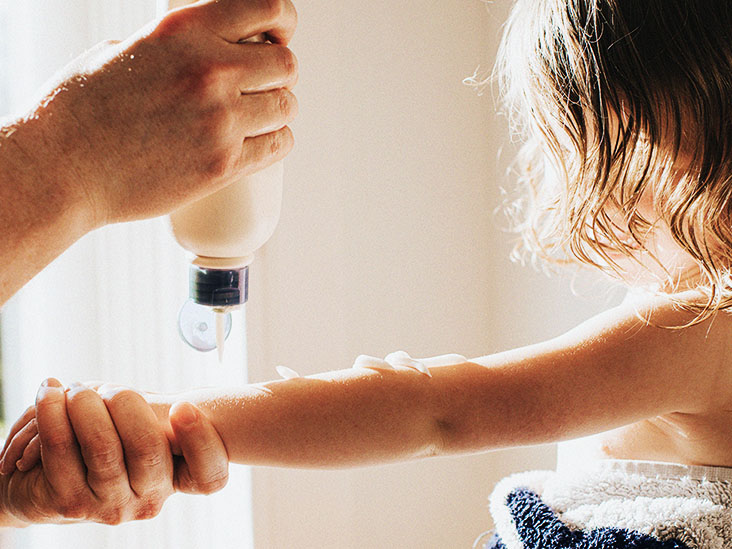
- Eczema affects up to one in five children, causing dry, irritated, and inflamed skin.
- A British children’s study found no difference in how well eczema responds to lotions, creams, ointments, or gels.
- However, some experts argue that certain moisturizers work better on different skin types and parts of the body.
Eczema refers to a spectrum of noncontagious skin conditions that trigger itchiness, inflammation, and discomfort. It typically develops in the first year of life.
Atopic dermatitis is the most common type that affects up to 20% of children.
Moisturizers, also known as emollients, may help treat symptoms, act as barriers to irritants, and reduce inflammation. These products are recommended or prescribed for soothing skin and preventing flare-ups, along with anti-inflammatories such as topical corticosteroids.
Research showing which moisturizer is best for eczema in children has been extremely limited. A trial in the United Kingdom is thought to be the first of its kind to compare the effectiveness of four main types of moisturizers: lotions, ointments, creams, and gels.
Dr. Matthew Ridd, the study lead from the Centre for Academic Primary Care at the University of Bristol in the U.K., says: “A study of this type has been long overdue […]. Our findings challenge conventions about how often moisturizers need to be applied, which types are less likely to cause problems and which patients should be recommended certain types […].”
The study’s results appear in The Lancet Child & Adolescent Health and the British Journal of General Practice.
Trial methods
Dr. Ridd and fellow researchers searched electronic medical records, then they screened and invited the parents or guardians of “potentially eligible children” to take part in their trial. After assessing over 12,000 children, 550 participated. The children were aged between 6 months and 12 years.
Subjects were randomly assigned to use one of the four types of emollients. The children’s family doctor prescribed the moisturizers with directions to “apply twice daily and as required.”
Parents reported their observations weekly for 16 weeks and followed up every four weeks until 52 weeks.
The researchers discovered that no emollient type stood out as more effective.
More than preference
Medical News Today discussed this research with Dr. Tien Nguyen, dermatologist at MemorialCare Orange Coast Medical Center in Fountain Valley, CA. He was not involved in this study.
Dr. Nguyen felt that the study’s sample size of 550 was “not a huge number, but adequate.”
He also agreed that the patient’s preference is a key consideration for treating eczema. However, he said that the effectiveness of emollients “depends on the location of the skin on the body [and] the severity of the disease.”
For instance, he explained, that the palms, feet, and soles typically respond well to ointments. On the other hand, creamy or lotion moisturizers might work better on the eyelids, upper lip, or neck.
More caveats
MNT also discussed this study with Dr. Teo Soleymani, dermatologist and surgeon at UCLA Health. He was not involved in this research.
Dr. Soleymani praised the study for its “real-world application.” However, he was disappointed that the study’s population mostly had the same white race:
“I think, in this group, the reason there was no significant difference […] is probably that all of these patients have the same skin type and same subtype of eczema.”
He insisted that this is significant because “patients with different skin types, for example, Asian skin or African American skin, who have eczema, tend to have different etiologies to their eczema.”
The dermatologist pointed out three main components of eczema:
- “a genetic barrier defect of the skin;
- hypersensitivity or immune overactivity to environmental allergens that get through the cracks in the skin; and
- an imbalance in the bacteria that live on our skin.”
Dr. Soleymani explained that eczema in Asian or African American skin tends to result from a genetic barrier defect known as filaggrin mutations. Subsequently, the skin becomes drier, ashier, and itchier, and it develops a rash.
These skin types typically “need something that’s greasier […], great barrier protection for those kids compared to ointments,” the dermatologist said.
The dermatologist pointed out that patients with inflammatory eczema don’t have dry skin. Instead, “their skin is super sensitive, so everything makes them red and irritated. These individuals require different treatments.”
The final say
Dr. Ridd and his team say that more studies are necessary to see if their findings apply to teens and adults with eczema or other dry skin issues.
Dr. Soleymani maintained that baby skin and elderly skin are similar, so his young and much older patients receive the same treatment recommendations.
The experts all agree, though, that the patient — not the health care provider — should use what works best to treat their eczema.
Source: Read Full Article
